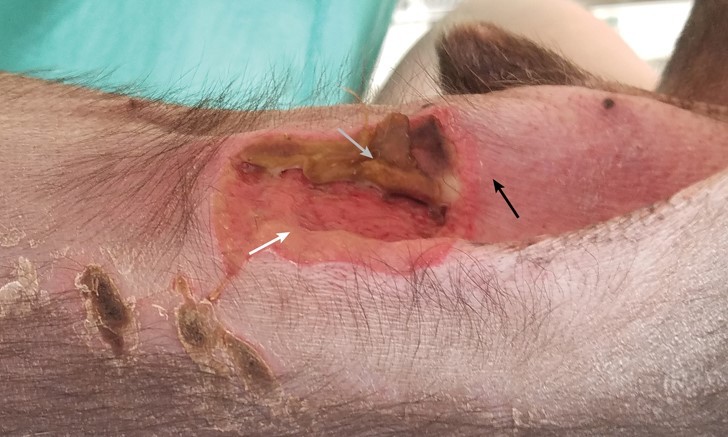Dermatologist Paulo Gomes, DVM, DACVD, Purdue University, outlines the management of burns in veterinary patients, the challenges of which begin with diagnosis of the type and extent of this painful injury.
Review your treatment strategies compared with those of this expert in this article from Clinician’s Brief, our official clinical practice journal.
Burns are painful injuries with partial or complete skin damage caused by heat (ie, thermal burn), chemicals, radiation, and/or electricity.1-4 Thermal burns are the most common burns in dogs and cats5 and can be caused by fire, liquids, and heating pads and other heating devices (eg, dryers, mufflers, stoves), among others.2,6,7
Burn severity is classified according to the depth and size of injury (see table in full article).3,8 Superficial burns affect only the outermost epidermis, whereas superficial partial-thickness burns encompass the epidermis and superficial dermis. Deep partial-thickness burns involve the full-thickness epidermis and extend to the deep dermis. Full-thickness and subdermal burns affect the epidermis, dermis, and subcutaneous tissue and can include fat, tendons, muscle, bone, and interstitium.8-10 Local burns involve <20% of total body surface area,3,8 whereas severe burn injuries—excluding outermost epidermal superficial burns (eg, sunburns)—affect >20% of total body surface area.11 Severe burn injuries can be superficial partial-thickness, deep partial-thickness, or full-thickness and subdermal.
In veterinary medicine, no method to estimate total body surface area has been ribed. Because of the various sizes and body conformations in veterinary patients, attempts to estimate the total body surface area involved in burn injuries using human methodology and body diagrams can lead to estimation discrepancies.3,11
Mild localized burns can result in local responses, and severe burn injuries can lead to life-threatening cardiovascular, respiratory, metabolic, and/or immunologic disorders.1-3,8-10,12
Localized responses consist of 3 zones of injury (ie, coagulation, stasis, hyperemia; Figure 1). The coagulation zone is the central area of maximum tissue damage and includes coagulation of proteins and irreversible tissue damage. The stasis zone is characterized by progressive thrombosis of surrounding vessels and decreased tissue perfusion. Tissue recovery in the stasis zone is variable. The outermost zone is the hyperemia zone and has increased perfusion and good tissue recovery.1,12

Figure 1. Heating pad burn in a Chihuahua. The 3 zones of injury (ie, coagulation [gray arrow], stasis [white arrow], hyperemia [black arrow]) are visible. Photo courtesy of Dr. Becky Zaremba
icon-doc-line
Read the full article
https://www.cliniciansbrief.com/article/burns?utm_medium=email&utm_source=Clinician%27s+Brief+Newsletter&utm_campaign=Global+200110

